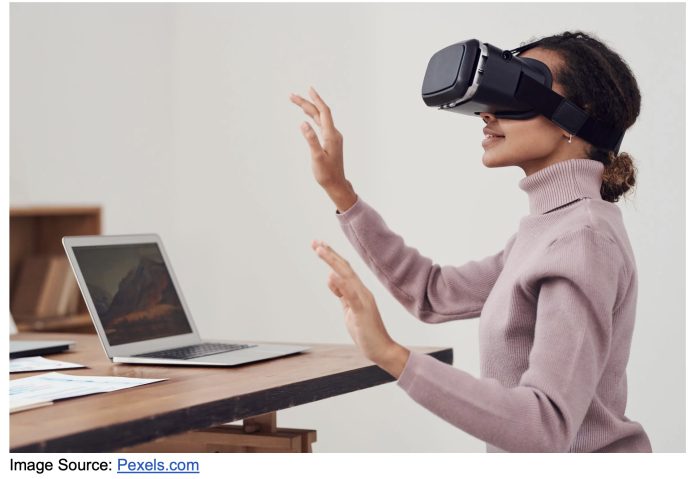
Evolutions in the working environment have created an increased need for job training that is interactive, safe, and efficient inside and outside of a physical, on-site workplace. With virtual reality (VR) and augmented reality (AR) devices and software, it has become simpler for employees to take part in “hands-on” training modules that are just as, if not more, effective as former training methods.
Let’s look at how artificial intelligence (AI) is opening doors to new ways individuals can receive job education throughout their careers and what VR/AR training modules currently are being implemented across various industries.
How VR and AI Are Altering Job Market Training
Remote work became largely popular during the height of the COVID-19 pandemic, offering new ways for businesses to conduct regular training, meetings, and the general hiring process. Interviews were conducted over Zoom. Information and documents primarily were transmitted through cloud-based filing systems. In addition, communication was largely through applications such as Slack, where instant messaging and task delegation were made easy. More than this, though, VR and AI applications found a firmer footing in the workforce for jobs that could not be conducted remotely.
Many industries, such as the manufacturing and agricultural industries, began using AI software to encourage social distancing while optimizing workplace procedures. Internet of Things (IoT) devices with sensor-based tracking technology made it easier for warehouses to keep track of inventory without having to resort to having more staff members in the workplace, essentially reducing word-of-mouth discrepancies, human error, and the spreading of the Coronavirus all in one.
However, AI developments and implementation didn’t just make current working processes more efficient—they allowed new and existing employees to receive the training they needed for optimal job performance. Studies have shown that worker performance can be enhanced by as much as 40 percent with AI. Combined with VR devices, AI software can track training progress and productivity statistics while assisting companies with identifying weak spots in training modules, adjusting them to become more digestible and helpful in the long run.
With VR devices, companies that used to require in-person job training in close quarters with other employees now can allow team members to use headsets and computers either at home or in safely distanced spaces, learning to operate machinery and complete daily tasks. Devices such as the Oculus Quest 2 or the DVPR P1 Pro-4K(ULTRA) are wireless, high-definition, and easy to navigate, letting employees perform the training with little oversight and intervention.
Exploring VR for Enhanced Job Training
VR for job training is becoming more common for many industries, including retail companies such as Walmart. In Walmart’s training facilities, which are called Walmart Academies, employees use Oculus Rift VR headsets to participate in simulated experiences that were otherwise difficult to train in person. The situations included Black Friday VR training, which helped employees prepare for the incredibly busy and often stressful holiday season.
The healthcare industry also has adopted VR training processes, preparing individuals to conduct life-saving measures in the workplace that cannot be routinely introduced in person.
When it comes to the architectural and construction industry, VR has simplified project collaboration and training. For meetings, team members can join a virtual meeting room where remote job site interaction is feasible, allowing members to offer viable solutions when visiting the actual location isn’t possible. Additionally, for employee training, VR offers an opportunity for team members to interact with dangerous job situations (such as underground construction projects) over and over again without risking their lives, developing the skills they need to complete this work in real life.
Benefits of AI and VR Implementation in Job Training
VR training offers the benefit of time, specificity, and safety, allowing employers to take their time training their employees without wasting valuable resources or subjecting them to unsafe working conditions. It is no secret that individuals learn differently, and it is hard to offer each employee the particular training they each require for efficient information and skills retention. With AI/VR training modules, working and learning happen simultaneously; AI software identifies and supplements knowledge gaps without the need for eventual retraining that eats away at productivity.
Virtual training is also more cost-effective and eco-conscious down the line. Business can avoid expending valuable energy resources again and again through repetitive training methods by using wireless headsets. It also can prevent the misuse of expensive machinery, which can force businesses to use excessive funds to replace equipment and can put new staff members in harm’s way.
Above all, VR provides the opportunity for employees to relieve themselves of the stress of learning new operations. Burnout is a large issue in the workplace, and many businesses have looked to ease this stress by incorporating AI chatbots for faster employee solutions and to identify high levels of fatigue at work, something that leaves team members susceptible to injury and mental health decline.
Through access to VR options, employees can develop and hone their skills at home or in a less stressful manner, working at their own pace and dealing with much less risk that can exacerbate feelings of tension and worry. The goal of technology in business should always be to solve existing problems and to alleviate pain points that impact employees—with VR implementation, you can target these concerns and create a work environment that fosters healthy, coherent productivity during the training process and beyond.




